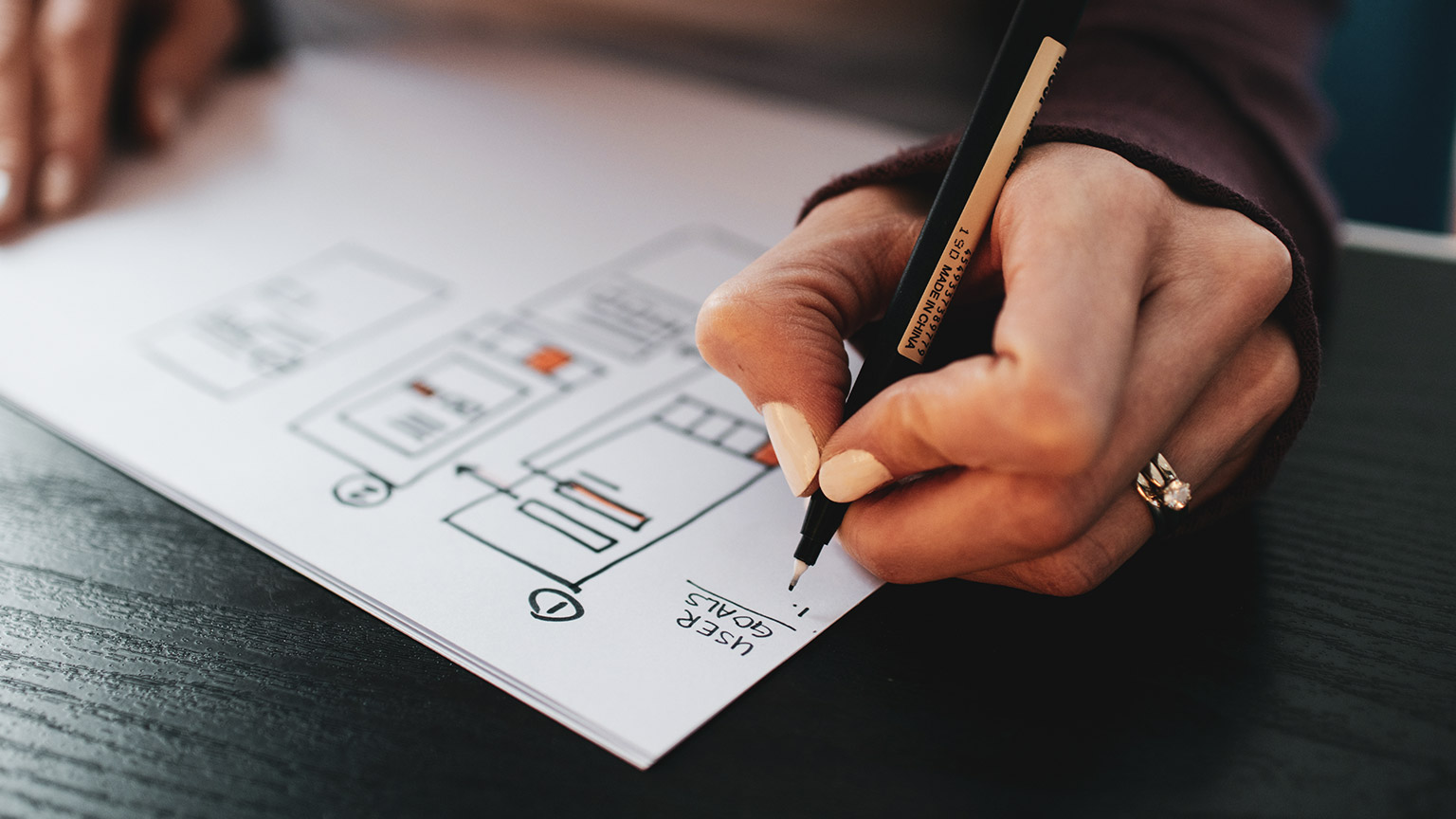A design process is an approach for breaking down a large project into manageable chunks. This process differs between industries, workplaces and job roles. Below we will cover a 10-step process.
1. Brief/proposal
Working with the client, build an understanding of their requirements and constraints. Gain an understanding of their market position and target audience. Using the information gathered, develop and agree on the brief.
(There is more information on brief writing and interpreting below.)
2. Planning
With the clients’ requirements and constraints in mind, carefully plan a timeline to include critical milestones for review, critique and deadlines.
Effective planning will maximise your chances of success. There are great project management tools to help you plan out your milestones; for example:
- Asana: allows you to create milestones, while also breaking them down into tasks and subtasks. Asana provides many different display options.
- Google Sheets: allows you to use provided templates or create your own.
- Trello: allows you to create boards and fill them with different lists.
- Nifty: incorporates project management with team collaboration. It includes functions similar to Asana, and allows you to view your project as a list of tasks, or as a map of your milestones on a Gantt chart.
- Team Gantt: as the name suggests, this software helps you create intricate Gantt charts.
It is good practice to show your client your timelines so that there is a transparent agreement. There is nothing worse than starting a project only to find out your client expected it completed in 1 week, not 4 weeks.
3. Research and analysis
Collect research, including examples for inspiration. Research is a broad step--this can include researching target markets, researching other projects and their style, researching about the client or about the industry etc.
This stage allows you to draw your inspiration and begin generating ideas.
A starting point for research should be understanding which decisions need to be made.
For example, if you are creating a design campaign for a pack of chewing gum:
- How many pieces are in the pack?
- How many shapes and sizes does the pack come in?
- What are their flavours?
- What demographics of people eat this chewing gum?
- What is the age and gender of the target market?
These elements of the process are covered in more detail below.
4. Idea generation
This is where the fun starts! Remember, your first idea will not likely be your best idea. Explore as many ideas as possible.
Carrying out the design process in an agile environment is suggested. What is an 'agile' environment? Well, there are 4 main pillars:
- individuals and interactions over processes and tools
- working software over comprehensive documentation
- customer collaboration over contract negotiation
- responding to change over following a plan.
Some great techniques for idea generation are covered in more detail below.
5. Concept development
Using the results from your idea generation, experiment and develop a range of concepts to explore. Concepts should be rough and convey just enough information to understand them. 'Mood boards' are a great way to share elements of a concept.
6. Evaluation of concepts
Evaluate each of your concepts. Get feedback and make notes. Share your concepts with the client, and decide which concepts to refine.
An important part of this is accepting criticism. Forbes has top tips on how to do this:
- Stop your first reaction.
- Remember the benefit of getting feedback.
- Listen for understanding.
- Say thank you.
- Ask questions to deconstruct the feedback.
- Request time to follow-up.
7. Refining concepts
Start focusing on the details by selecting typefaces, colours and colour palettes. Source images and text, refine the layout and arrangement of elements.
8. Final design
Recreate your refined concept using the appropriate software. Remember, you may not be the only person who needs to work on your file, so set it up in a way that is easily understood and name elements appropriately.
9. Proofing the final design
Check your work for accuracy by checking the spelling and grammar. Eliminate any typographical errors. Print, mock up and proofread your work. Make sure you get someone else to look over it before you share it with the client.
Let the client see the work and make any adjustments they require.

10. Present
Plan and practice your presentation. Explain how your design meets the client’s brief and why it is a great solution.
An excellent presentation will help build confidence in the work you have produced.
A design brief defines the outline and specifications of what you will be required to design. Depending on the situation, you may be given an explicit written design brief, a very basic brief, a verbal brief, or you may even have the opportunity to work with the client to create the brief.
Clients will often not know exactly what they require, so it is vital to write a design brief to set out the requirements. Having a brief will help you know when the project is finished.
What a design brief should identify
- The client: The client is who you will be creating the design for. It is good to know some background about the client--where they are located, what they do, their aims, and their history.
- Desired style: What style or ‘look’ does the client want to convey? Your client may be able to show you examples of styles they think will work for them. You can help by showing them styles and techniques that you think might work.
- Purpose: What will be the intended function of the design? Is it to raise awareness, to inform, or to sell a product?
- Outcomes: What exactly are you required to design? Is the outcome to be a poster, a brochure, an advertisement, a web page? (The anticipated outcome will likely influence some of the constraints mentioned later.)
- Target audience: Who is the design aimed at, and where will it be used? The target audience may combine many factors (such as gender, age, culture, location, interests and socioeconomics position). Your client may already know who they are targeting--they may be existing customers or people who already engage with similar content; or your client may be trying to attract engagement from a new demographic.
- Constraints, specifications and key factors: These are the limits or specifications you need to work within–specific content, document size, colours, media type, number of pages and the cost. Ask yourself whether there are any legal, political or ethical issues? Are there copyright concerns? Is the content morally suitable? Do you need to consult with anyone on any issues?
- Deadlines: As well as the final deadline, you should identify dates for key milestones (e.g. presenting your client with initial concepts, drafts and final proof). You should also set a personal time frame to keep your work on schedule (e.g. completion dates for idea generation, collecting research and a first draft).
- Include specific details: A design brief should ideally be as specific as possible. Not only does this set clear goals for you to meet, but setting boundaries helps create a focus for your creativity. A loosely written design brief can lead to time-wasting through too many possibilities and little direction.
- Refining the design brief: Refining the brief will be required as the design process progresses and more challenges become apparent. You should consult with the client and record any changes that are made to the brief.
- Writing your brief: If you are writing your own design brief, it is good to conduct initial research and investigation before committing yourself.
Interpreting a design brief
Identify design problems
You should identify any problems established by the brief. These are design challenges—what you need to solve to ensure that your design solution will be successful.
Seeking clarification
A design brief should be a 2-way document. You should try to interpret what the client wants, then question the client to clarify or expand any areas of concern. You may also suggest alternatives and negotiate any changes that need to be made to the brief. It is a good idea to document any significant points of clarification and provide a copy to the client.

Research
Research is a valuable part of the design process, yet can easily be overlooked or minimised. It is often considered easier to rely on what is easily accessible or right in front of you by using internet search engines or what you already know. While these are great sources to use, engaging in quality research and using a range of sources will give you a broader perspective on your brief.
Information sources
- Libraries: Most cities or towns have libraries with access to books, magazines and a vast range of reference material.
- Existing design solutions: Looking at how other designers have solved similar problems can help you discover how to create your solution.
- Site visits: Go to where the problem is. Look at what surrounds it. Get a feel for the environment.
- Other people: Talk to people connected to the problem. Talking to people who are disconnected from the problem may help to gain an alternative perspective.
- Books, magazines, videos: There are lots of great online sources for this type of content.
- Photograph albums: Remembering the past may spark some useful nostalgia.
Recording research activities
When you carry out a research task, you must make a record of it. The way you record the information will depend on the investigation strategy used and can usually be included as part of your visual diary.
This may mean you:
- use photographs or photocopies you take
- write down a summary of a conversation
- take notes from books or web pages you read (and include the title, author and URL of the information source).
If you do not record your research, you may lose a lot of information and the time you spent on it will have been wasted. Also, having nothing to show for the time spent does not look good from a client’s point of view. It is not acceptable to say that you have done the research but it is all in your head.
Analysing research
After you have researched and recorded any information, it is time to summarise and analyse its usefulness.
Summarise
If you obtain a large amount of information or read an interesting book, simply record the most significant points of relevance rather than presenting them in their entirety. If you have found hundreds of suitable images, choose a handful of the best.
Fewer and more concise pieces of information are almost always of more use.
Analyse
Once you have collected and summarised your research, you need to analyse it. You should identify what is significant about it, what is good or bad, and how it could be used in relation to your design concepts.
Try to give valid reasons to avoid making subjective decisions based on your personal opinions. Keep your comments short and to the point–you are not expected to write an analytical essay–one or two sentences will often be sufficient.
SCAMPER
SCAMPER is an idea generation technique beneficial when looking for ways to extend or improve an existing design, making it a great strategy to use during the development stages.
We can use SCAMPER, individually or in a team, by asking questions about the current design that forces us to think about it from alternative perspectives. (Watch the video below to familiarise yourself with this concept.)
Substitute
- What materials or resources can you substitute or swap to improve the product?
- What other product or process could you use?
- What rules could you substitute?
- Can you use this product somewhere else or as a substitute for something else?
- What will happen if you change your feelings or attitude toward this product?
Combine
- What would happen if you combine this product with another to create something new?
- What if you combine purposes or objectives?
- What could you combine to maximise the uses of this product?
- How could you combine talent and resources to create a new approach to this product?
Adapt
- How could you adapt or readjust this product to serve another purpose or use?
- What else is the product like?
- Who or what could you emulate to adapt this product?
- What else is like your product?
- What other context could you put your product into?
- What other products or ideas could you use for inspiration?
Modify
- How could you change the shape, look or feel of your product?
- What could you add to modify this product?
- What could you emphasise or highlight to create more value?
- What element of this product could you strengthen to create something new?
Put to another use
- Can you use this product somewhere else, perhaps in another industry?
- Who else could use this product?
- How would this product behave differently in another setting?
- Could you recycle the waste from this product to make something new?
Eliminate
- How could you streamline or simplify this product?
- What features, parts or rules could you eliminate?
- What could you understate or tone down?
- How could you make it smaller, faster, lighter or more fun?
- What would happen if you took away part of this product? What would you have in its place?
Reverse
- What would happen if you reversed this process or sequenced things differently?
- What if you try to do the exact opposite of what you're trying to do now?
- What components could you substitute to change the order of this product?
- What roles could you reverse or swap?
- How could you reorganise this product?
Mind mapping
'Mind mapping' is a connection visualisation technique that you may have already heard of. It was first developed by the English author and researcher, Tony Buzan, and discussed in his book Use your Head (1972).
Mindmapping.com describes a 6-step process (How To Make A Mind Map | MindMapping.com, n.d.).
- Enter the main topic: Start by entering the main subject in the centre of the mind map; for instance, 'Capitals of the world'.
- Brainstorm topics: Create main branches to enter your topics such as 'London', 'Paris', 'New York' and 'Beijing'. (Do not worry about the order of the topics.)
- Create subtopics: Elaborate on your topics by creating subtopics. (Use very short phrases or even single words.)
- Rearrange the topics: If you need to rearrange the topics in your mind map, most software tools allow you to drag-and-drop branches. This will enable you to structure the topics that you brainstormed.
- Add images and formatting: According to the mind mapping theory, images and colours improve memory retention. You can use different colours and fonts and place images on branches.
- Notes and research: Take notes of your topics and attached research files--if your mind mapping software allows this.
A sample mind map
Forced analogies
Analogies are a way of comparing 2 things to show how they are alike in order to make a point of the comparison.
We use analogies all the time in our day to day language: 'Life is like a box of chocolates–you never know what you’re gonna get.' You may remember this line from the film Forrest Gump (1994). The first part of the line is a simile comparing life to a box of chocolates. The addition of 'you never know what you’re gonna get' makes it an analogy by defining the point of the comparison.
Forced analogies use randomly-generated comparisons to spark new creative ways of looking at and solving a problem.
Think of 2 words, and join them up by the phrase ‘is like’. This will force your thought processes into places you may otherwise never have gone and should allow you to develop unique solutions to your task.
Ask yourself:
- How is my problem like a [insert random object]? List traits that could be shared between the problem and the object.
- How may I solve my problem with a [insert random object]? What aspects of the random object could be used to solve the problem?
- How would [insert famous person’s name] solve this problem? Think about how that person might approach the problem if it were part of their area of knowledge.
Try using this random object generator, https://perchance.org/object and this famous person generator https://www.randomlists.com/random-people.

Some basic rules for any idea generation session (whether you are working in a group or individually) include:
Consider everything that is suggested
When in a group situation, try not to criticise anyone’s ideas and try not to censor yourself when generating ideas. Avoid judging or dismissing anything before you explore it thoroughly. Stating the obvious is just as important as being creative or obscure. Be positive!
Try to gather large quantities of ideas
Quantity, not necessarily quality, is the aim of an idea generation session. You can throw out as much as you like after the session, and the more ideas you write down, the more you will generate.
Challenge your preconceptions and stereotypes
Be highly aware of your ways of thinking and deliberately try to break out of those patterns. It might seem scary, especially in a group situation, but try to eliminate your fear of making mistakes. There are no mistakes when generating ideas. Be honest and open, and you will find that your ideas will start to flow.
Build on ideas
Try to add extra thoughts to each idea. If you are generating ideas in a group, let yourself be inspired by other people’s ideas. Try combining ideas to create new ones. Stop, and return to, the process to maintain freshness and objectivity.
Record everything immediately
Make sure you write down every idea as soon as it is thought of. If you do not, then it may become subject to subconscious censorship and may never be recorded.
Make sure you are in a comfortable and relaxing environment
You’ll find that you are much more productive if you have set aside a specific time and place for an idea generation session. Make sure you can brainstorm undisturbed and have enough paper and pencils or pens. You might like to use music to help relax you. You might also find a pile of magazines or books useful for visual stimulation.
Listen to everyone else in the group
When you are in a group situation, remember to listen while thinking of your own ideas.
Do not interrupt or argue!
If you are on your own, listen to your thoughts and note down everything that comes into your head. Try not to use negative terminology–can’t, don’t, won’t.
Allow for wild and wacky ideas
Don’t stop yourself from suggesting something because you think it is too ridiculous. It is much easier to tone down ideas than it is to think of the perfect solution immediately. You will be surprised how radical ideas can set off thought processes. See how exaggerated you can be.
Creativity is the ability to see relationships where none exist.Author, Thomas M. Disch (1940-2008)

Forced analogy activity
'Forced analogies' make comparisons between seemingly dissimilar things.
Your task is to make a series of forced analogies with another online learner.
Start by making a list of 5 random things.
These could be:
- places
- people
- products
- manufactured things
- natural things.
For example:
- Te Papa – Museum of New Zealand
- Donald Trump
- a Tesla car
- Pohutakawa trees
- a carrot.
Share your list with another learner in the forum, and get a copy of their list.
Working independently and starting at the top of your list, compare the first item on their list with the first item on your list. Write down as many ways the two things could be 'like' each other.
For example:
A Tesla car is like a dog because…
- They both come when you call them. (Tesla cars have an autopilot feature that allows them to self-drive to your location in a parking lot.)
- Overheating is bad for both dogs and Tesla cars.
- They both need to be fed. (Electricity for the Tesla, dog food for the dog.)
Try to make at least 5 comparisons.
Repeat the process for all the items on your lists.
Share your results with the other learner, and share your favourite analogy with the rest of the learning community in the forum.
In this topic, we covered a 10-step process for design.
- Brief/proposal
- Planning
- Research and analysis
- Idea generation
- Concept development
- Evaluation of concepts
- Refining concepts
- Final design
- Proofing final design
- Present.
You read about what a design brief is, what it identifies, and how to interpret it. When in doubt, you should seek clarification from the client.
Research is a valuable part of the design process. You learned about ways of researching including site visits, libraries, photo albums, existing design solutions, books, magazines, and other people. Researching includes making records of research, summarising, and analysing.
We discussed 3 idea generation techniques. Mindmapping, forced analogies, and SCAMPER.
SCAMPER stands for;
- Substitute
- Combine
- Adapt
- Modify
- Put to other use
- Eliminate
- Reverse
Additional resources
Here are some links to help you learn more about this topic.
It is expected that you should complete 12 hours (FT) or 6 hours (PT) of student-directed learning each week. These resources will make up part of your own student-directed learning hours.
- WATCH Burger King's proposal to McDonalds - World Peace Day
- WATCH If McDonalds advertised like Apple
- Great pen tool game
- Some great examples of burger photos
- WATCH Good proposal writing
- Great link to realistic cakes
- WATCH 6 Ways to Brainstorm

